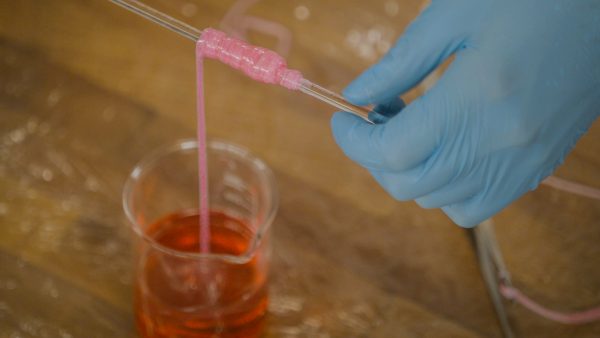If you are on a school computer or network, ask your tech person to whitelist these URLs:
*.wistia.com, fast.wistia.com, fast.wistia.net, embedwistia-a.akamaihd.net
Sometimes a simple refresh solves this issue. If you need further help, contact us.
Synthetic Materials Activity for Kids
Fake Worms DIY
- Duration: 20 min
- Difficulty: Easy
- Cost: $0 to $10
Use calcium chloride and sodium alginate to make fake worms!
Material List
- 2Tablespoons calcium chloride
- 0.5Teaspoons of sodium alginate
- 1Bowl with 1 cup of water
- 1Plastic bottle with 1 cup of water
- 1Food coloring
- 1Stirring utensil
- 1Pair of safety glasses
- 1Pair of gloves
Instructions
- 1Add 2 tablespoons of calcium chloride to the bowl of water and mix it.
- 2Into the bottle, add a few drops of food coloring and a half teaspoon of sodium alginate.
- 3Cap the bottle immediately and shake it for 30 seconds. It can take some time to dissolve.
- 4Pour the liquid in the bottle, into the bowl (try to make one continuous stream of liquid).
- 5Wait 10 seconds and pull out the new substance.
How It Works
The chemical reaction between two natural resources (calcium chloride and sodium alginate) forms a synthetic material. Sodium alginate comes from algae and calcium chloride comes from rocks. The gel-like substance is formed because the sodium alginate reacts with the calcium chloride, to form calcium alginate. Fun fact: this synthetic material is used by doctors to help wounds heal faster.
Find More
Exciting Activities
More Activities
Browse All
Full Lessons
Watch Full Lessons
Skip, I will use a 3 day free trial
Enjoy your free 30 days trial
We use cookies to make your experience with this site better. By using this site you agree to our use of cookies. Click "Decline" to delete and block any non-essential cookies for this site on this specific property, device, and browser. Please read our privacy policy for more information on the cookies we use.Learn More
We use cookies to improve your experience. By using this site, you agree to our use of cookies. Click "Decline" to block non-essential cookies. See our privacy policy for details.Learn More







